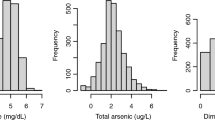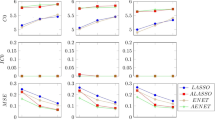Abstract
The relative risk/prevalence ratio and odds ratio are very popular in medical research and epidemiological studies. The odds ratio is overused in practice due to its direct relation with the logistic regression. Interpreting the odds ratio in terms of “relative risk” may lead to incorrect inference on the prevalence of certain event. In this paper, we propose to estimate the relative risk using the log-binomial model by maximizing the likelihood with a linear constraint, which can be easily implemented by an existing function, such as “constrOptim” in R. Furthermore, we review other existing methods and compare their performance under a variety of settings using simulated data. We suggest the proposed and COPY methods in practice, based on its performance in the simulations. For illustration, we investigate the vigorous physical activity effects on obesity using data from the National Health and Nutrition Examination Survey, and the treatment effects on lung cancer mortality using data in R.




Similar content being viewed by others
References
Barros AJ, Hirakata VN (2003) Alternatives for logistic regression in cross-sectional studies: an empirical comparison of models that directly estimate the prevalence ratio. BMC Med Res Methodol 3:21. http://www.biomedcentral.com/1471-2288/3/21
Blizzard L, Hosmer DW (2006) Parameter estimation and goodness-of-fit in log-binomial regression. Biometrical J 48:5–22
Carter RE, Lipsitz SR, Tilley BC (2005) Quasi-likelihood estimation for relative risk regression models. Biostatistics 6:39–44
Deddens JA, Petersen MR, Lei X (2003) Estimation of prevalence ratios when PROC GENMOD does not converge. In: Proceedings of the 28th annual SAS users group international conference. Paper 270-28
Lu M, Tilley BC (2001) Use of odds ratio or relative risk to measure a treatment effect in clinical trials with multiple correlated binary outcomes: data from the NINDS T-PA stroke trial. Stat Med 20:1891–1901
Lumley T, Kornmal R, Ma S (2006) Relative risk regression in medical research: models, contrasts, estimators, and algorithms, UW biostatistics working paper series. Paper 293. http://www.bepress.com/uwbiostat/paper293
McNutt LA, Wu C, Xue X, Hafner JP (2003) Estimating relative risk in cohort studies and clinical trials of common events. Am J Epidemiol 157:940–943
Nam J (1999) Power and sample size for testing homogeneity of relative risks in prospective studies. Biometrics 55:289–293
Savu A, Liu Q, Yasui Y (2010) Estimation of relative risk and prevalence ratio. Stat Med 29:2269–2281
Skov T, Deddens J, Petersen MR, Endahl L (1998) Prevalence proportion ratios: estimation and hypothesis testing. Int J Epidemiol 27:91–95
Thompson ML, Myers JE, Kriebel D (1998) Prevalence odds ratio or prevalence ratio in the analysis of cross sectional data: what is to be done? Occup Environ Med 55:272–277
Wacholder S (1986) Binomial regression in GLIM: estimating risk ratios and risk differences. Am J Epidemiol 123:174–184
Yu BB, Wang ZQ (2008) Estimating relative risks for common outcome using PROG NLP. Comput Methods Programs Biomed 90:179–186
Zhang J, Yu KF (1998) What’s the relative risk? A method of correcting the odds ratio in cohort studies of common outcomes. J Am Med Assoc 280:1690–1691
Zochetti C, Consinni D, Bertazzi PA (1995) Estimation of prevalence rate ratios from cross-sectional data. Int J Epidemiol 24:1064–1065
Zou GY (2004) A modified Poisson regression approach to prospective studies with binary data. Am J Epidemiol 159:702–706
Author information
Authors and Affiliations
Corresponding author
Appendix
Appendix
1.1 R code
1.1.1 Constraint function in R
For a purpose of illustration, let data$Y denote the binary outcome \(Y\), data$x denote the possible variable \(\mathbf x\) with dimension \(n\times (p+1)\), “loglike” denote the negative logarithm of likelihood function (3), and \(\hat{\beta }\) denote the estimator of \(\beta \). We illustrate the code for \(\hat{\beta }\) by “constrOptim” function. First, we set the starting value in a feasible region, such as \((-1, 0, \ldots , 0)\) since \(\exp (-1)<1\). Second, we need to specify the restriction region (4). In the “constrOptim” function, it can be realized by ui %*%\(\beta \) \(-\) ci \(\ge \) 0 with ui = \(-\)data$x and ci = (\(0, 0,\ldots , 0\)). We can obtain estimates of the log-binomial model by

Covariance matrix

1.1.2 Generate simulated dataset

1.1.3 COPY method

1.1.4 IPTW method

1.1.5 Poisson method

1.1.6 NLS method

Rights and permissions
About this article
Cite this article
Luo, J., Zhang, J. & Sun, H. Estimation of relative risk using a log-binomial model with constraints. Comput Stat 29, 981–1003 (2014). https://doi.org/10.1007/s00180-013-0476-8
Received:
Accepted:
Published:
Issue Date:
DOI: https://doi.org/10.1007/s00180-013-0476-8




